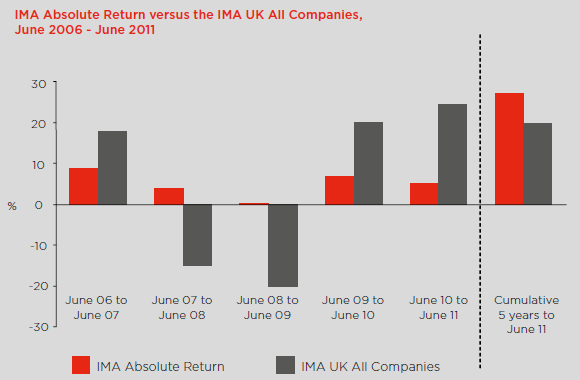What is Absolute Return?
Absolute return funds seek to deliver absolute (more than zero) returns for investors, regardless of the state of the underlying market. In contrast, an index-tracking fund or benchmark-relative fund (i.e. one that aims to beat a specific index) will tend to fluctuate with the direction of the underlying market.
Absolute returns can be achieved through a number of different strategies that allow the fund manager to achieve their goals whilst maintaining a focus on risk management. By utilising the sophisticated powers afforded to them through UCITS III,* absolute return fund managers can make full use of derivatives for investment purposes.
A common investment strategy that absolute return fund managers adopt is long/short equity investing, although absolute return funds do not just need to be focused on equities but might equally be invested in bonds, commodities, currencies or a combination of assets. Long positions mean simply expressing a positive view on a security by holding it directly in expectation of it rising in value. Short positions provide an opportunity to profit from a decline in the price of an asset; this should help the fund to achieve positive returns in a variety of market conditions.
It should be noted that absolute return does not mean that a positive return is guaranteed in all circumstances. Over the short term there may be periods of negative return. An absolute return fund’s investment process is structured, however, to be in a stronger position to reduce downside risk, whilst offering the potential for attractive longterm returns. A vital part of the absolute return skill-set is risk management, which is implemented through blending a rigorous process combined with the manager’s careful evaluation of opportunities and threats. Constant monitoring of a portfolio’s exposure and the impact of any trades is essential to achieving steady returns, independent of market conditions.
As the chart right demonstrates, the Investment Management Association (IMA) Absolute Return sector has delivered positive returns over each of the last five years. This is a period of particularly volatile markets when many asset classes fell sharply during the depths of the financial crisis in 2007 and 2008. In contrast, the IMA UK All Companies sector, which invests in UK equities, fell significantly in two of the periods.
Whilst past performance should not be taken as a guide to future returns, it is interesting to note that the absolute return sector behaved as expected, reducing volatility over the period. There is, of course, a trade-off; when asset markets rally, the absolute return funds may lag because their focus on liquidity and downside protection means they are not meant to fully capture the market upside. Reduced incidence of loss, however, should mean that positive returns compound over time, so a well-managed absolute return fund should, in theory, offer a competitive long-term return.
* Undertaking for Collective Investment in Transferable Securities – A European Union Directive defining the rules for collective investment schemes.
